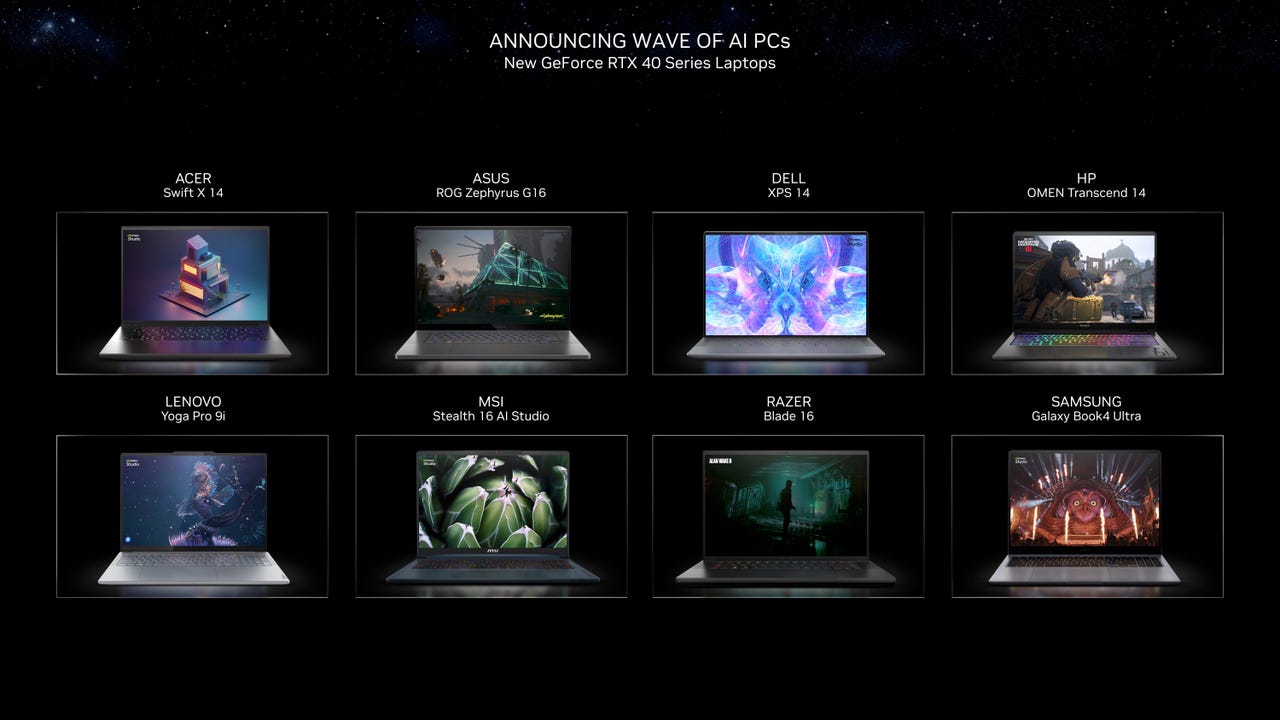Nvidia makes the case for the AI PC at CES 2024


Nvidia announced a wave of "AI-ready" laptops from partners using the company's new "Super" line of GPUs.
Chip giant Nvidia used the Consumer Electronics Show on Monday to unveil several product offerings for consumer technology, the automotive market, and robotics, and unveiled a slew of laptops focused on generative artificial intelligence technology of the ChatGPT sort.
"The big buzz at CES this year is gonna be all about generative AI and AI PCs," said Nvidia's senior director of product management, Justin Walker, in a briefing with reporters.
Also: CES 2024: What's Next in Tech
In the consumer AI area, Nvidia is positioning the personal computer as a platform for individual use of so-called "large language models" such as Meta's Llama 2 program and the popular image program Stable Diffusion.
The company on Monday announced a new series of its RTX graphics cards, called the RTX 40 Super series, that it says can generate video and images 1.7 times faster and 1.5 times faster respectively.
Several PC makers are introducing laptops, which Nvidia referred to as "AI-ready," with the new cards, including Acer, ASUS, Dell, HP, Lenovo, MSI, Razer and Samsung, which begin shipping this month, Nvidia said. The cards for workstations, in three models, 4070 SUPER, 4070i SUPER, and 4080 SUPER, will go on sale this month for $599, $799, and $999, respectively.
Building upon the release in October of a programming library, TensorRT-LLM for Windows, Nvidia emphasized the personal computer as a workstation for training large language models, in conjunction with cloud services.
The company's recently announced AI Workbench software for PCs will go live as a beta release later this month. It allows programmers to grab the language models from repositories such as Hugging Face and to send them to cloud computing facilities including Nvidia's own DGX Cloud. The RTX cards can then be used on the local PC for "inference and light customization," the company said.
Also: HP launches new AI-powered Spectre laptops at CES with flashy peripherals to match
Also in the consumer market, Nvidia made a big push for in-game avatars that are enhanced by automatically generated speech. Building upon a service previously announced, ACE, for "avatar cloud engine," the company announced "Production Microservices" for ACE that lets game developers plug into their games Nvidia programs for speech recognition and for facial animations.
As Nvidia's Walker explained, the technology will allow a player "to just talk to the game character," with their voice input fed into automatic speech recognition, "which translates that speech to text, then, we take the text and we feed that into a large language model to generate the character's response."
A large language model "can create an appropriate response and can create a response that's not canned — it won't be the same response every time," Walker explained. "That response can be vocalized using another model, a text to speech model, and then be passed on to yet another model which does an audio lip sync" so that the face muscles of the non-player character move in sync with the spoken response.
Also: I saw Samsung and LG's new transparent TVs at CES, and there's a clear winner
"That's a combination of four different AI models to make all this happen," noted Walker. "And those AI models, within our platform, are flexible: You can run those models on a cloud, you can run those models locally, on your RTX PC, so it can be powered to help provide this experience."
Building upon a service previously announced, ACE, for "avatar cloud engine," Nvidia announced "Production Microservices" for ACE that lets game developers plug into their games Nvidia programs for speech recognition and for facial animations.
Also for the consumer market, stock photography giant Getty Images announced a new service, Generative AI by iStock, which it built using Nvidia's "Picasso" program. The iStock service "allows anyone to create 4K imagery from text using an AI model trained on Getty Images' extensive catalog of licensed, commercially safe creative content," the companies said. The service is available immediately at istock.com.
In addition to the consumer initiatives, Nvidia emphasized news of customers and partners in the automative market, which always has concept cars on display at the show.
Nvidia announced new customer wins in electric vehicles, including Li Auto, which will use its "Drive Thor" computer platform, a board that Nvidia bills as a "centralized computer for safe and secure autonomous vehicles." In addition, EV makers GWM (Great Wall Motor), and Xiaomi will use the company's "DRIVE Orin" chips to achieve ADAS -- automated driver assistance -- functions, Nvidia announced.
Customer Mercedes-Benz's press conference featured the "Concept CLA Class," which uses Nvidia's "DRIVE Orin" chip platform. Nvidia noted that Mercedes-Benz is also using "digital twin" technology in its design process via Nvidia's Omniverse software platform for virtual reality application development.